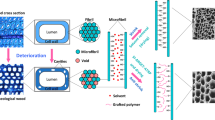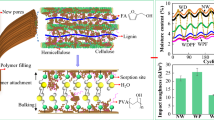Abstract
In this work, a new simple and environmentally friendly wood modification method was used to improve the dimensional stability of fast-growing wood. The wood samples were submerged in a neutral aqueous solution of 40% N-isopropylacrylamide/2-hydroxyethyl methacrylate (NIPAM/HEMA) at a mass ratio of 1/6 in the presence of catalytic amounts of 2,2′-azobis[2-methylpropionamidine] dihydrochloride (AAPH). The impregnated samples were heated at 60 °C for 12 h, followed by a heating period at 103 ± 2 °C for 12 h, in the course of which an in situ graft polymerization occurred in the cell wall. The results of scanning electron microscopy and energy-dispersive X-ray analyses indicate that the water-soluble vinyl monomers could effectively permeate into the wood cell walls. Infrared spectra showed that water-soluble monomers were in situ polymerized in wood. The results of XPS indicate that the water-soluble vinyl monomers could graft onto wood cell walls. The dimensional stability of poplar wood modified by the water-soluble vinyl monomers treatment was remarkably improved compared with that of untreated poplar wood.






Similar content being viewed by others
References
Abraham S, Brahim S, Ishihara K, Guiseppi-Elie A (2005) Molecularly engineered p (HEMA)-based hydrogels for implant biochip biocompatibility. Biomaterials 26:4767–4778
Bryne LE, Lausmaa J, Ernstsson M, Englund F, Wålinder ME (2010) Ageing of modified wood. Part 2: determination of surface composition of acetylated, furfurylated, and thermally modified wood by XPS and ToF-SIMS. Holzforschung 64(3):305–313
Cabane E, Keplinger T, Künniger T, Merk V, Burgert I (2016) Functional lignocellulosic materials prepared by ATRP from a wood scaffold. Sci Rep 6:31287
Chang HT, Chang ST (2006) Modification of wood with isopropyl glycidyl ether and its effects on decay resistance and light stability. Bioresour Technol 97:1265–1271
Chen-Yang Y, Chuang J, Yang Y, Li C, Chiu Y (1998) New UV-curable cyclotriphosphazenes as fire-retardant coating materials for wood. J Appl Polym Sci 69:115–122
Cleland MR, Galloway RA, Berejka AJ, Montoney D, Driscoll M, Smith L, Larsen LS (2009) X-ray initiated polymerization of wood impregnants. Radiat Phys Chem 78:535–538
Donath S, Militz H, Mai C (2004) Wood modification with alkoxysilanes. Wood Sci Technol 38:555–566
Fernández-Fernández M, Sanromán MA, Moldes D (2014) Potential of laccase for modification of Eucalyptus globulus wood: a XPS study. Wood Sci Technol 48(1):151–160
Furuno T, Imamura Y, Kajita H (2004) The modification of wood by treatment with low molecular weight phenol-formaldehyde resin: a properties enhancement with neutralized phenolic-resin and resin penetration into wood cell walls. Wood Sci Technol 37:349–361
Ghavami S-M, Mesbahi A, Pesianian I, Shafaee A, Aliparasti M-R (2010) Normoxic polymer gel dosimetry using less toxic monomer of N-isopropyl acrylamide and X-ray computed tomography for radiation therapy applications. Rep Pract Oncol Radiother 15:172–175
Gindl W, Gupta H (2002) Cell-wall hardness and Young’s modulus of melamine-modified spruce wood by nano-indentation. Compos A Appl Sci Manuf 33:1141–1145
Hill CAS, Jones D (1999) Dimensional changes in corsican pine sapwood due to chemical modification with linear chain anhydrides. Holzforschung 53:267–271
Hill CA, Farahani MM, Hale MD (2004) The use of organo alkoxysilane coupling agents for wood preservation. Holzforschung 58:316–325
Horák D, Červinka M, Půza V (1997) Hydrogels in endovascular embolization: VI. Toxicity tests of poly (2-hydroxyethyl methacrylate) particles on cell cultures. Biomaterials 18:1355–1359
Huang Y, Li G, Chu F (2019) In situ polymerization of 2-hydroxyethyl methacrylate (HEMA) and 3-(methacryloxy) propyltrimethoxysilane (MAPTES) in poplar cell wall to enhance its dimensional stability. Holzforschung 73(5):469–474
Ivanova AV, Gerasimova EL, Gazizullina ER, Kozitsina AN, Matern AI (2016) Kinetics of the thermal decomposition of 2, 2′-azobis (2-methylpropionamidine) dihydrochloride studied by the potentiometric method using metal complexes. Russ Chem Bull 65:419–424
Jin C, Song W, Liu T, Xin J, Hiscox WC, Zhang J, Kong Z (2018) Temperature and pH responsive hydrogels using methacrylated lignosulfonate cross-linker: synthesis, characterization, and properties. ACS Sustain Chem Eng 6(2):1763–1771
Keplinger T, Cabane E, Berg JK, Segmehl JS, Bock P, Burgert I (2016) Smart hierarchical bio-based materials by formation of stimuli-responsive hydrogels inside the microporous structure of wood. Adv Mater Interfaces 3:1600233
Kumar S (2007) Chemical modification of wood. Wood Fiber Sci 26:270–280
Liu X, Xu Y, Yu J, Li S, Wang J, Wang C, Chu F (2014) Integration of lignin and acrylic monomers towards grafted copolymers by free radical polymerization. Int J Biol Macromol 67:483–489
Lou X, Munro S, Wang S (2004) Drug release characteristics of phase separation pHEMA sponge materials. Biomaterials 25:5071–5080
Miyasaka K, Nakabayashi N (1999) Combination of EDTA conditioner and phenyl-P/HEMA self-etching primer for bonding to dentin. Dent Mater 15:153–157
Naha PC, Casey A, Tenuta T, Lynch I, Dawson KA, Byrne HJ, Davoren M (2009) Preparation, characterization of NIPAM and NIPAM/BAM copolymer nanoparticles and their acute toxicity testing using an aquatic test battery. Aquat Toxicol 92:146–154
Qiu J, Gaynor SG, Matyjaszewski K (1999) Emulsion polymerization of n-butyl methacrylate by reverse atom transfer radical polymerization. Macromolecules 32:2872–2875
Raju R, Bandyopadhyay S, Sharma A, Gonzalez S, Carlsen P, Gautun O, Glomm W (2018) Synthesis, characterization and drug loading of multiresponsive p [NIPAm-co-PEGMA](core)/p [NIPAm-co-AAc](Shell) nanogels with monodisperse size distributions. Polymers 10:309
Śliwa T, Jarzębski M, Andrzejewska E, Szafran M, Gapiński J (2017) Uptake and controlled release of a dye from thermo-sensitive polymer P (NIPAM-co-Vim). React Funct Polym 115:102–108
Tuong VM, Li J (2011) Changes caused by heat treatment in chemical composition and some physical properties of acacia hybrid sapwood. Holzforschung 65:67–72
Walther UI, Siagian II, Walther SC, Reichl FX, Hickel R (2004) Antioxidative vitamins decrease cytotoxicity of HEMA and TEGDMA in cultured cell lines. Arch Oral Biol 49:125–131
Wang K, Dong Y, Yan Y, Zhang S, Li J (2018) Improving dimensional stability and durability of wood polymer composites by grafting polystyrene onto wood cell walls. Polym Compos 39:119–125
Acknowledgements
The authors are very grateful for financial support from the National Key Research and Development Program of China (2017YFD0600203).
Author information
Authors and Affiliations
Corresponding authors
Ethics declarations
Conflict of interest
The authors declare no competing financial interest.
Additional information
Publisher's Note
Springer Nature remains neutral with regard to jurisdictional claims in published maps and institutional affiliations.
Rights and permissions
About this article
Cite this article
Huang, Y., Li, G. & Chu, F. Modification of wood cell wall with water-soluble vinyl monomer to improve dimensional stability and its mechanism. Wood Sci Technol 53, 1051–1060 (2019). https://doi.org/10.1007/s00226-019-01112-0
Received:
Published:
Issue Date:
DOI: https://doi.org/10.1007/s00226-019-01112-0




